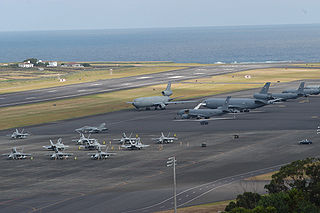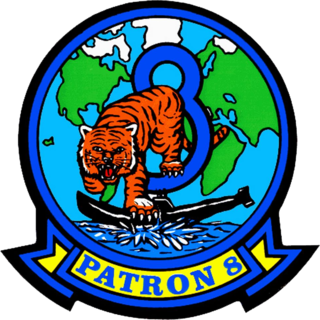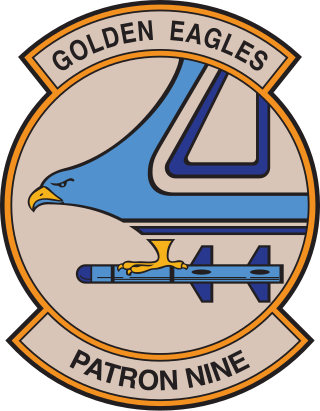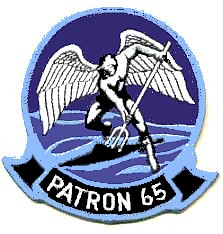
The Lockheed P-3 Orion is a four-engined, turboprop anti-submarine and maritime surveillance aircraft developed for the United States Navy and introduced in the 1960s. Lockheed based it on the L-188 Electra commercial airliner; it is easily distinguished from the Electra by its distinctive tail stinger or "MAD" boom, used for the magnetic anomaly detection (MAD) of submarines.

The Lockheed P-2 Neptune is a maritime patrol and anti-submarine warfare (ASW) aircraft. It was developed for the US Navy by Lockheed to replace the Lockheed PV-1 Ventura and PV-2 Harpoon, and was replaced in turn by the Lockheed P-3 Orion. Designed as a land-based aircraft, the Neptune never made a carrier landing, but a small number were converted and deployed as carrier-launched, stop-gap nuclear bombers that would have to land on shore or ditch. The type was successful in export, and saw service with several armed forces.

The Lockheed CP-140 Aurora is a maritime patrol aircraft operated by the Royal Canadian Air Force. The aircraft is based on the Lockheed P-3 Orion airframe, but mounts the electronics suite of the Lockheed S-3 Viking. "Aurora" refers to the Roman goddess of dawn who flies across the sky each morning ahead of the sun. Aurora also refers to the Aurora Borealis, the "northern lights", that are prominent over northern Canada and the Arctic Ocean.

The Boeing P-8 Poseidon is an American maritime patrol and reconnaissance aircraft developed and produced by Boeing Defense, Space & Security. It was developed for the United States Navy (USN) as a derivative of the civilian Boeing 737-800 airliner.

Patrol Squadron 10 (VP-10) is a United States Navy Patrol Squadron based at Naval Air Station Jacksonville in Jacksonville, Florida, United States. It is nicknamed the "Red Lancers" and is equipped with the Boeing P-8A Poseidon. It is the third squadron to be designated VP-10. The first VP-10 was redesignated VP-2D15 on 21 September 1927 and the second VP-10 was redesignated VP-25 on 1 July 1939.

Lajes Field or Lajes Air Base, officially designated Air Base No. 4, is a multi-use airfield near Lajes and 15 km (9.3 mi) northeast of Angra do Heroísmo on Terceira Island in the Azores, Portugal. It is home to the Portuguese Air Force Base Aérea N º4 and Azores Air Zone Command, a United States Air Force detachment unit, and a regional air passenger terminal. Located about 3,680 km (2,290 mi) east of New York City and about 1,600 km (990 mi) west of Lisbon, Portugal; the base sits in a strategic location midway between North America and Europe in the north Atlantic Ocean.

No. 10 Squadron is a Royal Australian Air Force (RAAF) signals intelligence (SIGINT) squadron based at RAAF Base Edinburgh, South Australia. It is part of No. 92 Wing RAAF. The squadron was formed in 1939 as a maritime patrol unit. It saw active service during the Second World War, conducting anti-submarine operations and patrols from bases in the United Kingdom until it disbanded in late 1945. It was re-formed in Australia in 1949 and since then has contributed to Australia's East Timor intervention, and has been deployed to the Middle East as part of the War on Terrorism and the 2003 Gulf War. Most recently it now has a signals intelligence mission.

The Portuguese Air Force is the aerial warfare force of Portugal. Locally it is referred to by the acronym FAP but internationally is often referred to by the acronym PRTAF. It is the youngest of the three branches of the Portuguese Armed Forces.

No. 92 Wing is the intelligence, surveillance and reconnaissance wing of the Royal Australian Air Force, to include conducting maritime patrol, anti surface and submarine warfare, and electronic warfare. Headquartered at RAAF Base Edinburgh, 92WG is part of the Surveillance and Response Group. 92 Wing currently comprises four squadrons – No. 9 Squadron, No. 10 Squadron, No. 11 Squadron, and No. 292 Squadron. The wing also has a detachment headquarters at RMAF Base Butterworth in Malaysia. 92WG operates 12 P-8A Poseidon maritime patrol aircraft, and is acquiring the MQ-4C Triton unmanned aerial system (UAS), and the MC-55A airborne intelligence, surveillance, reconnaissance and electronic warfare aircraft. The P-8A is multi-role platform, capable of F2T2EA. Its roles include anti-submarine and anti-surface surveillance and warfare, for which the aircraft are equipped with MK54 torpedoes and Harpoon anti shipping missiles. It is also responsible for long range intelligence, surveillance, reconnaissance and maritime attack missions, Naval support and search and survivor supply missions. The Australian Maritime search area of responsibility constitutes approximately 11% of the Earth's surface, the largest area of responsibility for any single country.

The Lockheed AP-3C Orion is a variant of the P-3 Orion used by the Royal Australian Air Force (RAAF) for tasks such as naval fleet support, maritime surveillance, search and survivor supply and anti-surface and anti-submarine warfare. The 18 AP-3C Orions were upgraded from P-3Cs between 1997 and 2005, with the program taking three years longer than expected due to systems integration problems. All 18 AP-3C Orions are operated by No. 92 Wing which is based at RAAF Base Edinburgh in South Australia. Aircraft from the wing have seen service as part of Australian Defence Force operations in Australia, South East Asia and the Middle East.

Beja Air Base, officially designated as Air Base No. 11 is one of the most important military airbases in Portugal, 9 km (5.6 mi) northwest of Beja, 100 km (62 mi) north of Algarve. It is used by the Portuguese Air Force (PoAF) and has two parallel runways in the 01/19 direction, the biggest being 3,450 m × 60 m. The base is home to two training squadrons, one helicopter squadron and one maritime patrol squadron.

201 Squadron "Falcões" is a fighter squadron of the Portuguese Air Force, operating the F-16 Fighting Falcon.

Patrol Squadron Eight (VP-8) is a U.S. Navy land-based patrol squadron stationed at Naval Air Station Jacksonville, Florida (USA). VP-8 is tasked to undertake maritime patrol, anti-submarine warfare (ASW), and intelligence, surveillance and reconnaissance (ISR) missions. The Squadron is equipped with the Boeing P-8A Poseidon.

Patrol Squadron Four (VP-4) is a U.S. Navy land-based patrol squadron based at the Naval Air Station Whidbey Island, Oak Harbor, Washington, which is tasked to undertake maritime patrol, anti-submarine warfare (ASW), and intelligence, surveillance and reconnaissance (ISR) missions flying the Boeing P-8 Poseidon.

Patrol Squadron 9 (VP-9) is a U.S. Navy patrol squadron with its homeport located at Naval Air Station Whidbey Island. As of 2018, VP-9 is part of Patrol and Reconnaissance Wing Ten, Commander, Naval Air Forces, Pacific.

401 Squadron "Cientistas" was an aerial reconnaissance, photography and maritime patrol squadron of the Portuguese Air Force disbanded in 2011. The squadron also conducted counter-narcotic operations, monitoring of marine pollution in the Portuguese exclusive economic zone, and natural resource surveying.

Sintra Air Base, officially designated as Air Base No. 1, is a Portuguese Air Force base located in the Sintra Municipality, Portugal. The base is home to a flight training squadron and the Portuguese Air Force Academy.

VP-65, nicknamed the Tridents, was a Patrol Squadron of the U.S. Navy Reserve. The squadron was established on 16 November 1970 at NAS Los Alamitos, California, and moved on 6 January 1971 to NAS Point Mugu. It was disestablished on 4 March 2006, after 35 years of service. Elements of the squadron made 22 major overseas deployments.

In the Japan Maritime Self-Defense Force (JMSDF), the Fleet Air Force is its naval aviation branch, responsible for both fixed-wing and rotary aircraft and headquartered in Naval Air Facility Atsugi. As of 2012, it was equipped with over 200 fixed-wing aircraft and 150 helicopters. These aircraft operate from bases throughout Japan, as well as from the JMSDF's ships.




















